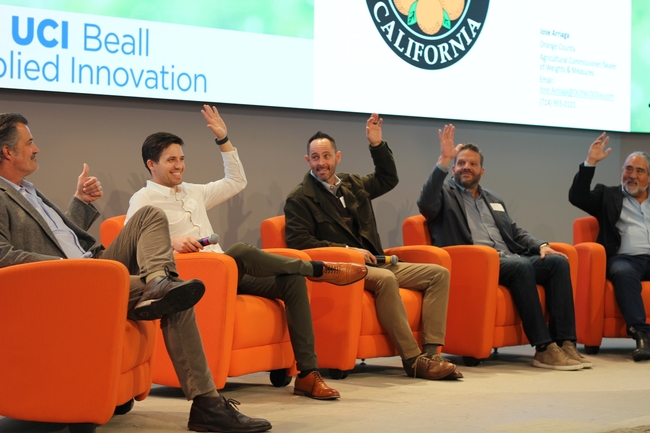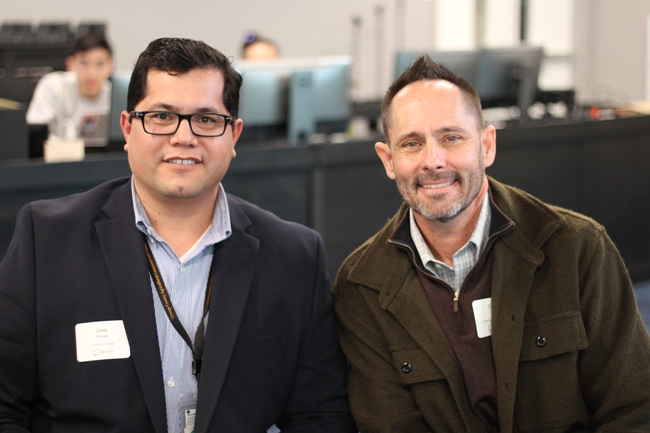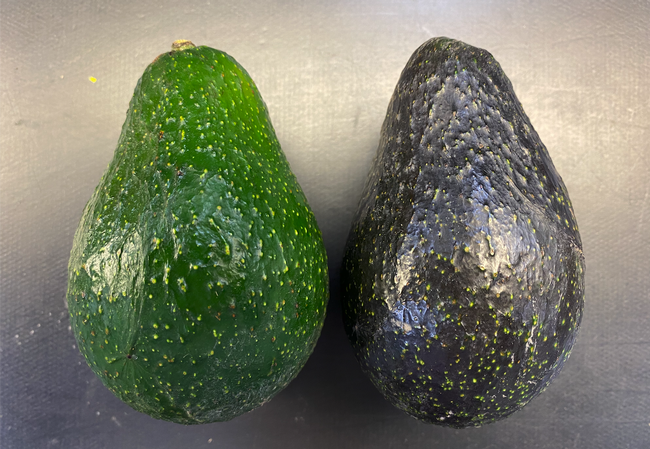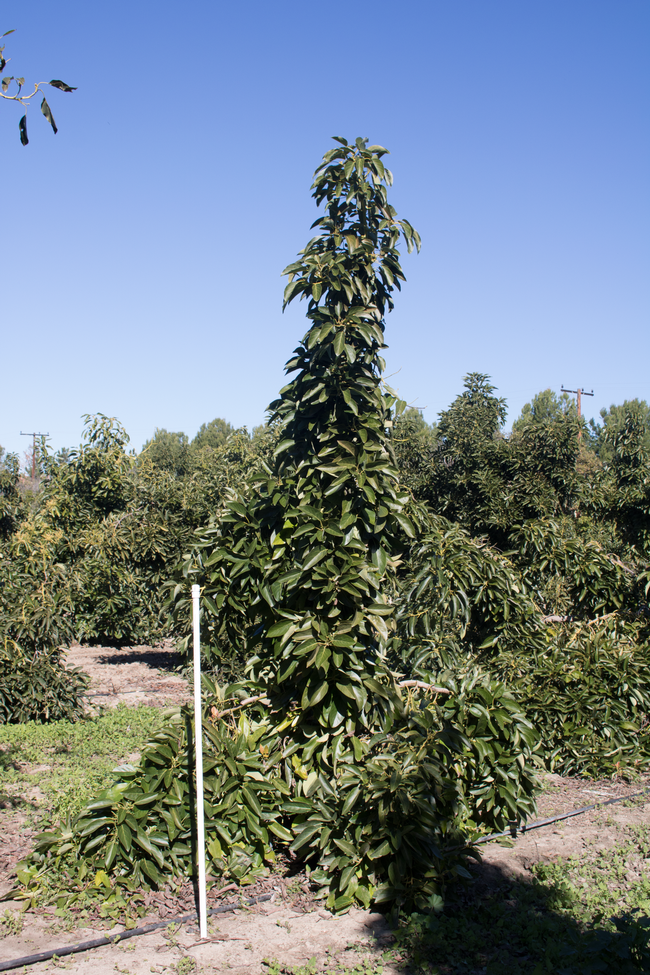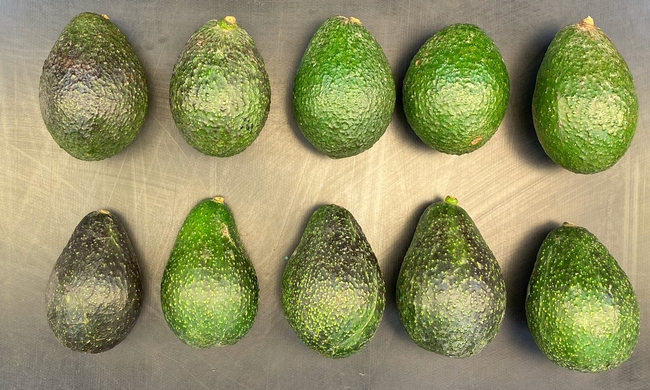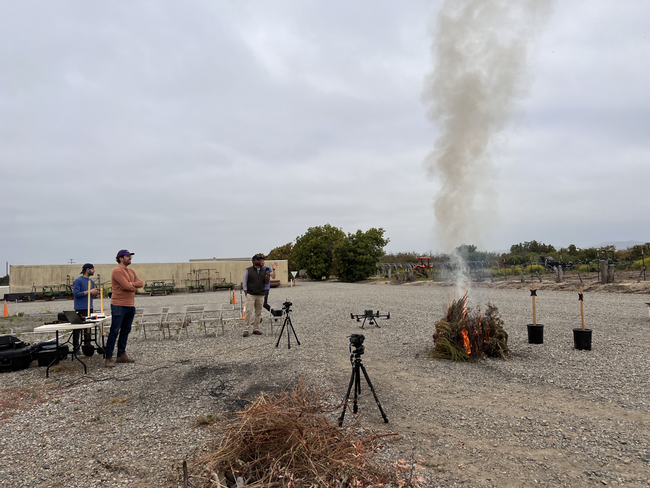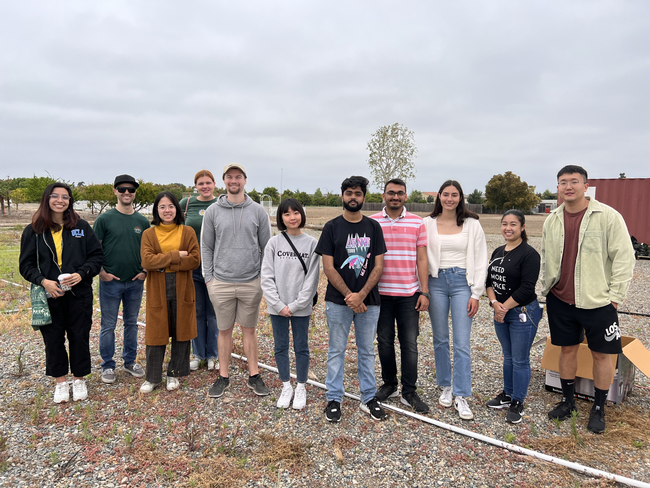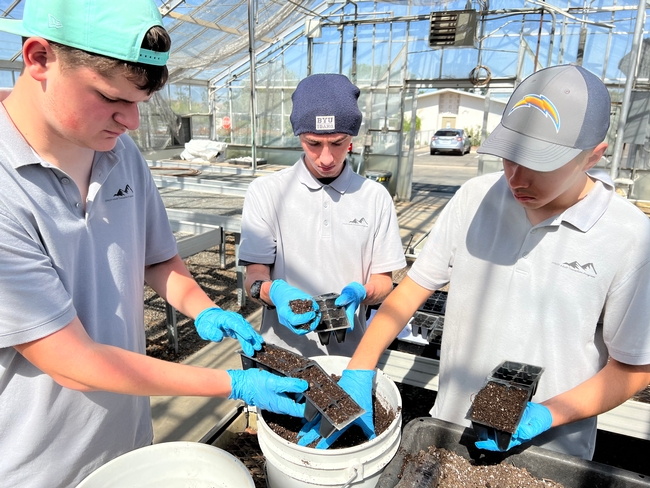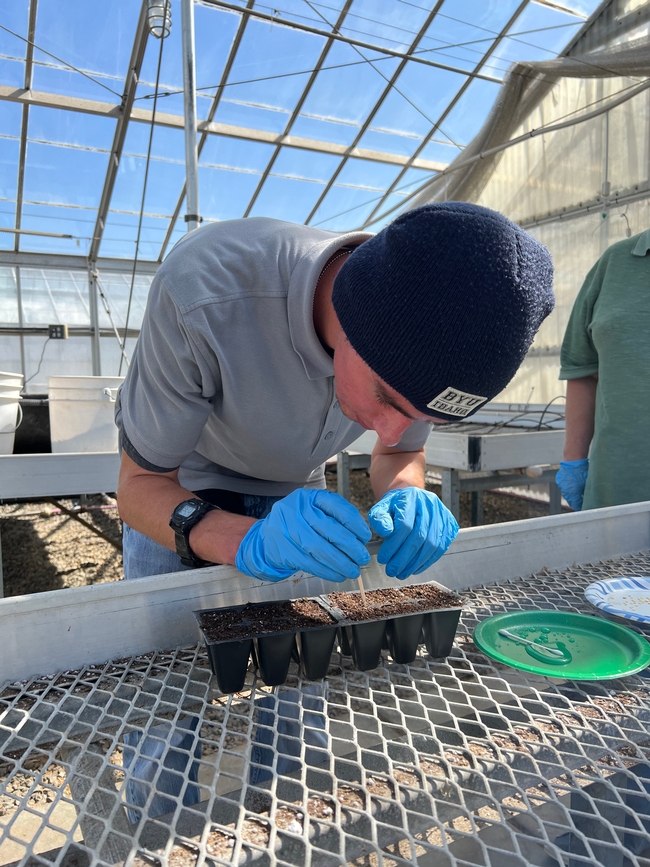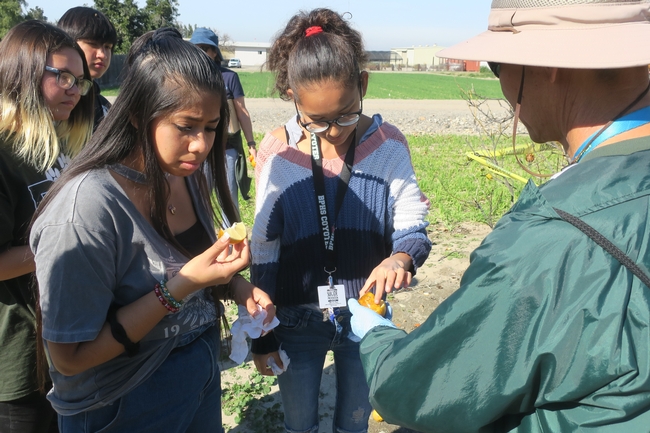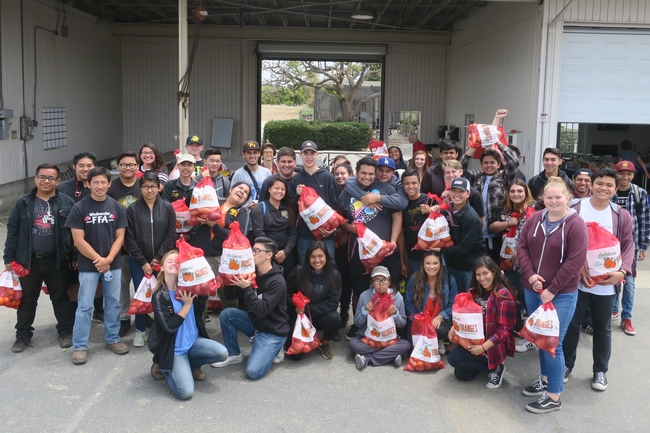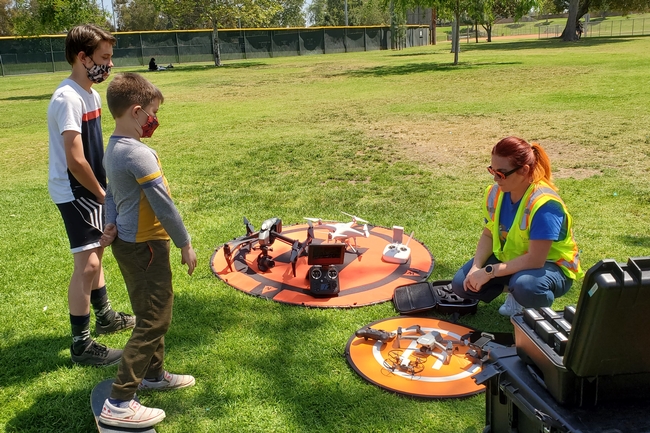Posts Tagged: South Coast
REC System Director Haver encourages systemic approach to agriculture
Agriculture generates $59 billion and employs nearly 400,000 individuals in California. The industry, however, is often threatened by challenges like climate change, land conversion and water scarcity. Motivated to act, Sustain Southern California – an organization associated with UC Irvine Beall Applied Innovation – hosted a roundtable discussion on Feb. 20 featuring subject matter experts including Darren Haver, director of UC Agriculture and Natural Resources' Research and Extension Center System.
During his keynote address, Jose Arriaga, Orange County Agricultural Commissioner, defined sustainability as food and fiber production that does not compromise the ability for future generations to meet their needs. In doing so, he acknowledged the benefit of discussing such timely topics with key players, especially for places where agriculture is not as prevalent as it used to be.
“Many people don't think of Orange County as a place for agriculture. It's probably because less land is being reserved for agriculture, not like back in the day. And that worries me,” said Arriaga.
The first roundtable discussion centered on sustainable agriculture, with Haver participating alongside other industry leaders based in Southern California, including A.G. Kawamura of Orange County Produce, Steve Brazeel of Sunterra Produce and Elevated Foods, Anthony Curci of Buttonwood Ranch and Parker Cohn from Performance Resource Management.
In discussing today's generation, Haver said that he has seen a shift over the last few decades away from yield alone, which used to be the most important aspect of production in agriculture. Today, much more attention is dedicated to sustainability – a change that Haver attributes to the younger generation of researchers and plant scientists working in agriculture.
There has also been an emphasis on sustaining the environment while maintaining economic progress. Haver recognized these important elements, but highlighted the social impact of sustainability, too.
“I don't have all the answers, but I do believe that addressing the environmental, economic and social aspects of agriculture is important. I also think that these factors should be addressed systemically rather than in silos,” said Haver.
Southern California agricultural producers, in particular, are responsible for $7.8 billion in gross receipts and nearly 100,000 jobs directly related to agriculture. In Orange County alone, where Haver is based at the South Coast Research and Extension Center, agriculture makes up $86 million of total economic output, with nurseries leading as a top commodity followed by fruit trees, vegetable production and livestock and apiary.
New avocado proves tasty, safer to harvest at UC ANR Research and Extension Centers
A new avocado, one that complements the widely known ‘Hass,' will hit the world market soon. The ‘Luna UCR' variety (trademarked and patent pending) has several characteristics that should be of interest to both growers and consumers, said Mary Lu Arpaia, University of California Cooperative Extension subtropical horticulture specialist based at UC Riverside.
From the grower perspective, the tree is about half the size of the leading variety while producing approximately the same yield per tree as ‘Hass,' meaning that growers could plant more trees per acre, therefore increasing yield. It also makes harvesting easier and safer.
Another advantage is the flowering behavior of the tree. Avocado trees are categorized into either Type A or Type B flower types. It is generally accepted that you need both flower types in a planting to maximize productivity. The ‘Hass' is an “A” flower type and ‘Luna UCR' is a Type “B.”
This is a potential boost for growers since the current varieties that are “B” flower types ripen green and generally receive lower prices for the grower. Similar to ‘Hass,' however, the ‘Luna UCR' colors as it ripens.
“Hopefully, it will receive similar returns to the ‘Hass' once it is an established variety,” Arpaia added.
Fruit breeding is a long-term process that she has navigated by building upon the work of her predecessors. Of course, Arpaia has had strong support from colleagues as well, including Eric Focht, a UC Riverside staff researcher and co-inventor of ‘Luna UCR.'
“We had been looking at ‘Luna UCR' for some time and it was always a very good eating fruit,” Focht said. “After the 2003 release of ‘GEM' (registered and patented as ‘3-29-5', 2003) and ‘Harvest' (patented as ‘N4(-)5', 2003) varieties, ‘Luna UCR' was always the top contender for a next release due to the small, narrow growth habit, “B” flower type and the fruit quality.”
“It's a very nice-looking fruit as well and seemed to be a pretty consistent bearer from year to year.”
A glimpse at how it all started
In spring 1996, Arpaia took over the UC Avocado Breeding Program following Guy Witney who led the program from 1992 to 1995, and Bob Bergh whose initial efforts in the 1950s were foundational in the inception of ‘Luna UCR.'
Arpaia recalls the first trials in the early 2000s of ‘Luna UCR,' which were tested alongside other promising selections from the Bergh program. “There were a lot of varieties that didn't perform well, some of which had poor storage life, an important trait that we need if we are going to get the fruit to consumers across the country,” said Arpaia.
The original seed and selection were planted at the Bob Lamb Ranch in Camarillo, and originally advanced trials of the ‘Luna UCR' variety were planted in four locations: UC Lindcove Research and Extension Center in Tulare County, UC South Coast Research and Extension Center in Orange County, a privately owned farm in San Diego County and another one in Ventura County.
The RECs are among the nine hubs operated by UC Agriculture and Natural Resources to support research and educate the public on regional agricultural and natural resource challenges.
ANR Research and Extension Centers become vital
Unfortunately, the 2017 Thomas Fire burned the avocado trees in Ventura, said Arpaia. After a change in management, the trial located in San Diego County was also terminated, leaving the two trials at Lindcove and South Coast REC.
“South Coast REC has a long history of supporting research and extension activities of high value crops important to California, including avocados,” said Darren Haver, director of the South Coast REC, which was often used to show growers the new varieties that were being developed.
“Many of the REC staff have worked with the avocado-breeding program researchers for more than two decades and continue to work closely with them to ensure the success of new avocado varieties, including ‘Luna UCR',” he added.
In addition to the support provided by South Coast and Lindcove RECs, Arpaia said that UC Kearney Agricultural Research and Extension Center in Fresno County – another UC ANR facility – made it possible for her team to conduct critical postharvest and sensory research, and consumer testing of the fruit, which included up to six-week trials of fruit ratings for storage life and taste.
“UC ANR has played an important role in our ability to not only identify ‘Luna UCR', but in preparing it for the world market, too,” she said.
Preparing to share with the world
Since 2015, Focht had been collecting data for the patent application. Now that he and Arpaia have successfully patented and trademarked ‘Luna UCR,' they are preparing to expand production by engaging interested growers with the commercial partner, Green Motion who is based in Spain.
“Green Motion contracted for 1,000 trees to be generated by Brokaw Nursery and those trees are currently being distributed, with earliest field plantings likely taking place in fall,” explained Focht.
Focht also said that Mission Produce, based in Oxnard, CA has contracted to graft over a small number of “B” flower type pollinizer trees to the new ‘Luna UCR' variety, possibly making way for a small number of avocados to be available the following year.
Once planted, the avocado trees will come into “full” production in about five years.
To read this story in Spanish, visit: https://ucanr.edu/blogs/blogcore/postdetail.cfm?postnum=58991
Cooperative Extension fire advisor and UC graduate students gather around the fire
Besides starting fires for the sake of research, Luca Carmignani, UC Cooperative Extension fire advisor for San Diego, Orange, Los Angeles, and Riverside counties, has started leveraging his connection to local UC campuses by providing opportunities for hands-on learning.
Early one morning in May, students and staff from UC Irvine and UC Riverside gathered at the South Coast Research and Extension Center to collect data for their own research projects. South Coast REC, located in Irvine, is part of a statewide network of research and education facilities operated by UC Agriculture and Natural Resources.
In one area of the field, graduate students picked leaves and twigs from dried shrubs, carefully placing them in a device that measures moisture content. In another area, a postdoctoral scholar set up a device that records levels of particulate matter, carbon dioxide and other air pollutants emitted by a fire.
Tirtha Banerjee, professor in the Department of Civil and Environmental Engineering at UC Irvine, coordinated the field day with Carmignani. The two first connected as members of iFireNet, an international network of networks that connect people to fire research, when Carmignani was a postdoctoral researcher at UC Berkeley.
Now, the two are collaborating to help environmental science and engineering students realize the potential of their research interests.
Jacquelynn Nguyen, a Ph.D. student in the Civil and Environmental Engineering department at UC Irvine, is interested in understanding how ash from wildfires and prescribed burns can be used as a treatment for per- and polyfluorinated substances. PFAS are a group of “forever chemicals” that can be found in heat-resistant materials – including fire extinguisher foam – and are extremely difficult to eliminate.
Before Nguyen could collect her ash samples, Carmignani needed to cautiously set the dried shrubs on fire, providing a realistic situation for data collection purposes.
“We're trying to figure out if the ashes from these fires can be used as activated carbon, which could be used as a treatment for PFAS,” said Nguyen. “We want to see if this treatment can basically absorb PFAS and prevent it from traveling into soil and groundwater.”
While Nguyen is concerned about the impact that wildfires have on the land, Soroush Neyestani, a postdoctoral scholar in the Environmental Sciences department at UC Riverside, is interested in its impact on the air quality.
During a fire, it's difficult to determine how much emissions are a result of flames versus smoldering, the process of burning slowly with smoke but no flames, and current air quality models do not provide accurate guidance on this matter. Using an air quality sensor, Neyestani wants to quantify the difference in emission levels during the two phases.
“There are assumptions that 50% of emissions come from smoldering, but every fire is different. Our main objective is to improve the accuracy of air-quality forecasting,” Neyestani said, noting his concern that these assumptions might not be realistic.
Although the field day was created with the students in mind, Carmignani used the opportunity to polish his own research efforts. Since fall 2022, he has been investigating the flammability of low-water use landscape plants based on various irrigation applications.
“Every time we burn, I feel like we get better. We get better data, and we conduct better analysis, and that's really important for us so that we can figure out how we can apply our research and measure its outcome,” said Carmignani.
In addition to welcoming more collaborations with UC campuses and other organizations, Carmignani is hopeful that these combined research efforts will spark an interest in wildfire awareness everywhere.
South Coast REC supports school-to-work pipeline for students with disabilities
Before Brent Flory, 22, started bagging fruits and vegetables at his local Stater Bros. Market, he picked them at the University of California South Coast Research and Extension Center in Irvine.
In partnership with Saddleback Unified School District's Esperanza Education Center, an adult transition program that provides independent living and life skills training for students with disabilities, South Coast REC hosts students on its 200 acres of land and introduces them to careers in agriculture.
Flory recalls picking avocados as one of his favorite moments from the program at South Coast, one of nine RECs across California operated by UC Agriculture and Natural Resources. “I picked a huge avocado and got to bring it home. It was the size of a medium pumpkin,” he shared.
Field work doesn't warrant business attire, but Flory said that working at South Coast REC taught him the importance of dressing appropriately for work. In this case, it meant pants, closed-toe shoes, a shirt with sleeves, and sunscreen or a hat if working in the sun.
While program managers hope that participating students would pursue a career in agriculture, South Coast REC is more concerned about providing opportunities for students to gain real work experience in a unique setting.
“This is the first time I have had the opportunity for my students to work at a job site in the agricultural field. We never really thought of the agricultural industry as an option for our students,” said Esperanza's education specialist, Michael Seyler.
Esperanza's partnership with South Coast REC began in October 2019. Since then, nine participants have been assigned to work at the research center where they help create seedlings, plant and harvest crops, and learn plant management.
Ray Bueche, Adult Transition Program coordinator and Career Start administrator at Esperanza, is proud of the creative energy it took to develop the program and unite partners, crediting Jason Suppes, South Coast REC's community education specialist. “Working with Jason and UC ANR has inspired me to continue to reach for unique partnerships in this field and elsewhere,” Bueche said.
Dylan Shelden, 19, another past participant, said that the program revealed how important it is for him to choose a career that makes him feel happy and independent. “You are responsible for yourself,” he said. “So, don't quit on the first try.”
Shelden currently works at Party City as a store organizer. Even though he prefers working indoors, Shelden described working with plants and being outdoors as refreshing. “Working in agriculture makes me feel good,” he said.
When asked what advice he would give incoming students, Shelden said: “Be kind, mindful, and thoughtful to others.”
“Things are constantly changing at the farm and follow seasonal patterns. Students get to work with different types of produce depending on the season. So many of my students only thought about jobs in retail or food services industries,” said Seyler. “This has opened their eyes to other possibilities.”
The soft skills learned while working at South Coast REC has helped other students secure paid competitive employment during or following the program. It has also inspired program staff like Bueche and Seyler to consider other unique opportunities for their students to connect the skills they have learned on the farm to other types of jobs.
To learn more about the Adult Transition Program at Esperanza Education Center, visit: https://www.svusd.org/schools/alternative-schools/esperanza/about/why-esperanza
Orange County Farm Bureau gift elevates UC programs that inspire youth in agriculture
Commitment of $690,000 supports UC South Coast Research and Extension Center, 4-H programs
During a “GROW Field Day” when 100 high school students enjoyed harvesting and tasting avocados, the Orange County Farm Bureau announced a $690,000 gift to expand University of California-affiliated programs that introduce young people to agricultural careers.
The students from four schools across Southern California participated in the GROW program on May 13 at the UC South Coast Research and Extension Center in Irvine, a UC Agriculture and Natural Resources facility that organizes and hosts these educational programs.
“Part of the mission of Orange County Farm Bureau is to support the development of the next generation of agriculturalists,” said Casey Anderson, executive director of OCFB, in announcing the five-year commitment that will begin in 2023. “Through our partnership with South Coast Research Extension Center and support of Orange County 4-H, we are thrilled to provide opportunities to young people to directly connect with food production and myriad research and career opportunities in agriculture.”
Hundreds of local youth are served every year by Orange County 4-H, a part of a nationwide youth development and education program, administered in California by UC ANR.
“OCFB contributions to our Forever 4-H Endowment will soon provide sustaining funds every year, indefinitely,” said Rita Jakel, Orange County 4-H program coordinator. “And their commitment to our Program Support Fund will help ensure that 4-H will continue to have the capacity to impact the youth of Orange County.”
GROW program introduces youth to agriculture careers
The GROW program, originally conceived by OCFB as a way to make agricultural experiences more accessible to more young people across the region, has engaged over 1,000 students from nine schools – many of them in urban areas where knowledge of agriculture is limited. The program builds on a strong history of collaboration between OCFB and South Coast REC, dating back to the early 2000s.
“UC ANR and South Coast Research and Extension Center are grateful for the trust the Orange County Farm Bureau continues to place in us to not only deliver agricultural education to the people of Orange County, but also to open the eyes of young people to fulfilling careers in agriculture,” said Darren Haver, director of UC South Coast REC.
“To me, it's like a great big outdoor classroom,” said Tammy Majcherek, a South Coast REC community educator specialist who coordinates the GROW program, along with colleague Jason Suppes. “There are so many possibilities of what we can connect to.”
Programs spotlight diversity of agriculture-related fields
Gina Cunningham, a teacher at Westminster High School (part of the Huntington Beach Unified School District), was excited to bring the 20 freshmen in her agricultural biology class to the GROW Day, where they get a glimpse of potential pathways in agriculture that “are not directly farming-related.”
“This gives kids an opportunity to see some things that are available to them that maybe they never have thought of – and there are a lot of things out there that I might not have thought of, either,” said Cunningham, who has degrees in animal science and agricultural education.
Thanks to OCFB's long-term commitment to the program, GROW coordinators Majcherek and Suppes said that in the coming years they would like to bring more students with career aspirations outside of traditional agricultural roles. In particular, they hope to reach out to young people with interests in culinary arts and food service, as well as in technology and engineering, which intersect with food production in the form of drones, robotics and artificial intelligence.
Regardless of their background, however, almost all of the students love harvesting crops from the South Coast REC farm, whether pumpkins, potatoes, or – during the most recent GROW Day – avocados. Majcherek said it's especially rewarding to hear the students talk enthusiastically about older siblings who went to a GROW program and came back with enduring memories – as well as some fresh produce.
“You know it's cool when they're taking selfies with their bounty,” she said.
Community members interested in joining the Orange County Farm Bureau in support of South Coast REC and 4-H programs are encouraged to make a donation on UC ANR's annual Giving Day, which runs from noon to noon on May 19-20.

